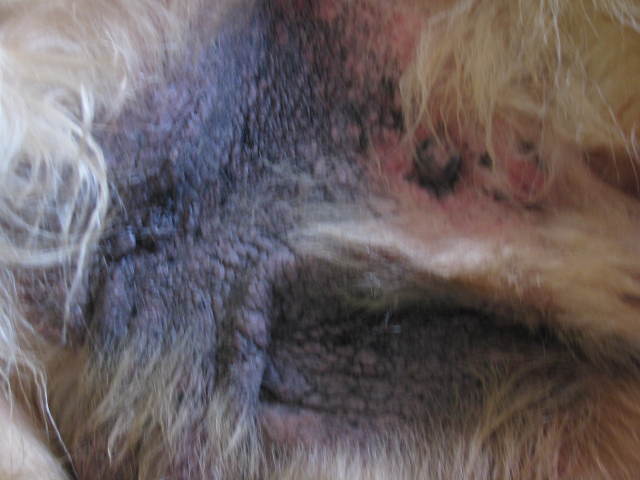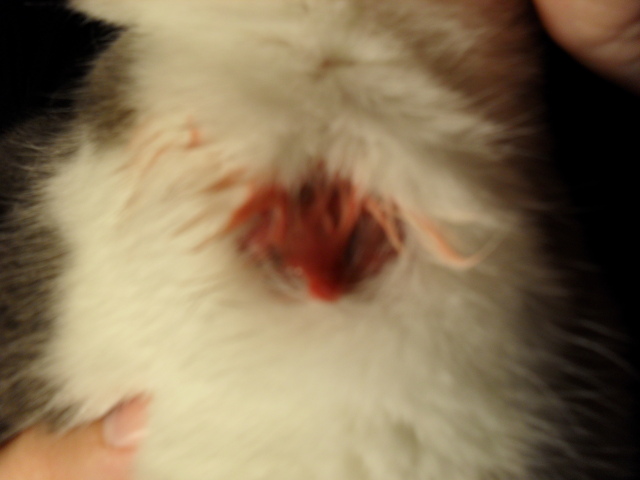QuestionMy spayed English Bulldog has just been diagnosed with the early stages of Hypothyroidism. Her veterinarian says that it is too early to treat her with medication. I assume that as the condition progresses she will be given a replacement thyroid hormone. Her only symptoms now appear to be a patch on either side of her body where the hair has fallen out. What should I expect as this condition progresses?
Are there any supplements or diet changes that I could make to slow down the condition or lessen the symptoms?
AnswerHello,
If she is having hair loss and her thyroid level is low, then she should be started on thyroid replacement now. Typicall symptoms are poor hair coat (dry and brittle), hair loss and weight gain despite limited food intake. There isn't a whole lot to do diet-wise to change the condition of an underactive thyroid except avoid giving broccoli and veggies related to that family as they can lower thyroid levels. Below is more info on thyroid.
GOOD LUCK!
DR. Fry
Hypothyroidism
Thyroid deficiency, hypothyroidism
AffectedAnimals:
Generally, hypothyroidism affects middle-aged dogs between the ages of two and six years. Any dog can develop hypothyroidism, but boxers, cocker spaniels, golden retrievers, miniature schnauzers, Old English sheepdogs, poodles, Shetland sheepdogs, and Doberman pinschers have a higher incidence of the disease. Very rarely, cats may develop the disease as well.
Overview:
The thyroid gland maintains the body's metabolism. When there is a decrease in levels of the thyroid hormones, the dog's body essentially "slows down" because of a lower cellular metabolic rate. As a result, the body will begin to lose its ability to function properly. The signs of slowed function vary and occur gradually, but tend to include drowsiness, weight gain, personality changes such as depression, and an inability or unwillingness to exercise. The animal's skin also may be affected, and patches of hair loss and darkened pigmentation are not uncommon. In more severe cases, the heart rate may slow and the dog may have neuromuscular complications such as seizures.
Generally, dogs show signs of hypothyroidism when they are in middle age, between the ages of two and six years, although some animals are affected earlier. Thyroid hormone replacement medications usually are effective in regulating the dog's metabolism and improving its quality of life, but when the hypothyroidism is a result of a damaged pituitary gland or cancer, additional complications may occur.
Clinical Signs:
Clinical signs vary and are gradual in onset, but typically include: lethargy, listlessness, or drowsiness; mental depression; exercise intolerance; weight gain; personality change; seeking out warm places; and infertility in some breeding animals. Additional symptoms include hair loss on the tail and along the trunk or body, resulting in a "rat tail" appearance; dry or oily skin associated with hyperpigmentation, or darkened skin; and thickening of the skin. The cardiovascular system can develop bradycardia, which is a decreased heart rate. Neuromuscular signs may include seizures; ataxia or stumbling; circling; knuckling or dragging the feet that results in the dorsal, or top, part of the nails being worn down; and forelimb lameness.
Symptoms:
See clinical signs.
Description:
The thyroid gland is responsible for cellular metabolism in the body. A decrease in the thyroid hormones causes a lower cellular metabolic rate and this affects the body's ability to function properly.
There are two types of hypothyroidism that can affect dogs. The first is called primary or acquired hypothyroidism, which is the most common form of this disorder. Primary hypothyroidism occurs by either one of two methods: when the thyroid gland is attacked by the body's immune system, or when the thyroid gland atrophies, or wastes away, for unknown reasons. The end result in both cases is the inability of the thyroid gland to secrete important hormones that regulate the body's metabolism.
The second type of hypothyroidism is called secondary hypothyroidism, which involves the destruction or malfunction of the pituitary gland in the brainstem. A poorly functioning pituitary gland is unable to produce the TSH hormone that stimulates the thyroid gland's production of the thyroid hormones. When TSH is not produced, neither will the thyroid hormones.
Diagnosis:
The most common way to diagnose hypothyroidism is to measure baseline blood levels of the thyroid hormone called T4. Decreased hormone levels are indicative of hypothyroidism; however, other non-related diseases and medications will also lower levels of this hormone. When clinical signs exist together with a low T4 level, a definitive diagnosis of hypothyroidism usually can be made. Commonly, the veterinarian will order a CBC, or complete blood count, as well as a serum chemistry panel to look for changes consistent with hypothyroidism. More specialized tests, such as a complete thyroid hormone panel, may be needed if a normal T4 is found and the dog has clinical signs of hypothyroidism.
Prognosis:
Dogs with primary hypothyroidism that are being treated appropriately with thyroid hormone supplementation have a good prognosis and are expected to have a normal life span. Dogs with secondary hypothyroidism have a guarded to poor prognosis because of the possibility of cancer or destruction to the pituitary gland which is located in the brain stem.
Transmission or Cause:
Causes of hypothyroidism include congenital disorders, cancer, infection, and drugs such as glucocorticoids.
Treatment:
Treatment involves synthetic thyroid hormone supplementation with medications such as sodium levothyroxine. Oral supplementation generally will be given daily for the remainder of the dog's life. Frequent re-examinations by the veterinarian will be needed to evaluate the blood levels of the thyroid hormone to be sure that the appropriate dose is being given. When too much hormone supplementation is given, a condition called thyrotoxicosis can occur. This condition, which is quite uncommon, may result in clinical signs such as panting, nervousness or anxiety, weight loss, diarrhea, increased drinking and increased urinating, aggressive behavior, and increased appetite.
Prevention:
Prevention of complications of hypothyroidism includes lifelong supplementation of synthetic thyroid hormone and periodic re-examinations by a veterinarian to check the blood levels of the hormone.

 Bloody Hair Ball
Question
My Little Girl
My indoor cat vomited up a very
Bloody Hair Ball
Question
My Little Girl
My indoor cat vomited up a very
 Radioiodine treatment of hyperthyroidism in our cat
Question
Molly
Dear Jana,
I wrote you near the end of
Radioiodine treatment of hyperthyroidism in our cat
Question
Molly
Dear Jana,
I wrote you near the end of
 male golden retriever rash on underbelly
Question
Rowdys belly
My granparents are big dog lovers
male golden retriever rash on underbelly
Question
Rowdys belly
My granparents are big dog lovers
 Stinky Cat
QuestionHi Marie,
I work with a dog/cat rescue in my a
Stinky Cat
QuestionHi Marie,
I work with a dog/cat rescue in my a
 My Cat Has some kind of abrasion
Question
The abrasion
I noticed my cat had some
My Cat Has some kind of abrasion
Question
The abrasion
I noticed my cat had some